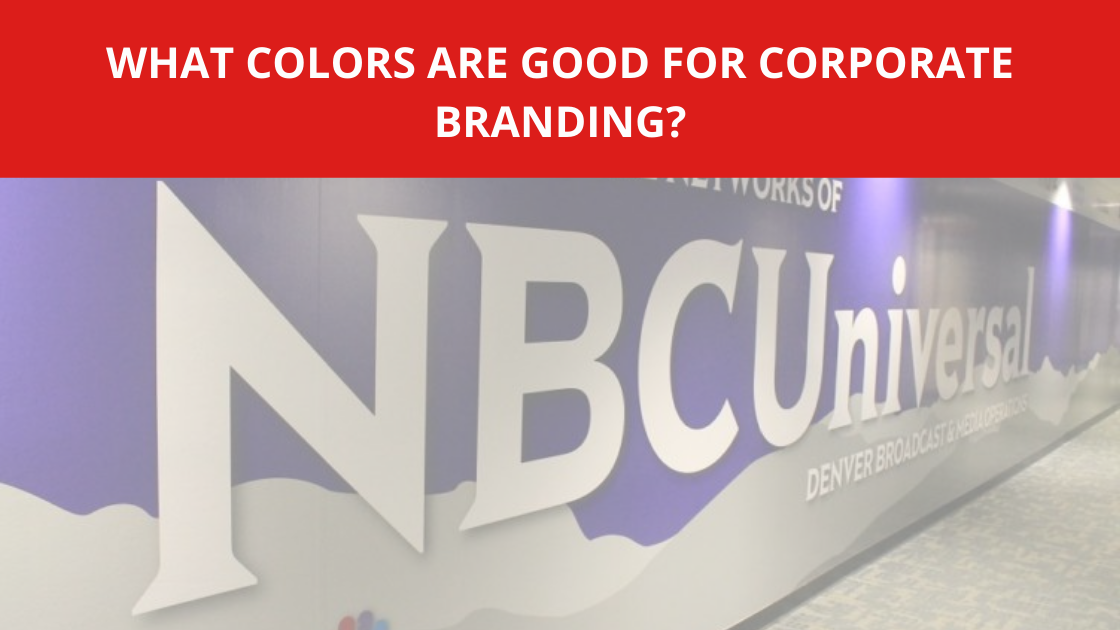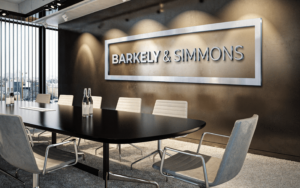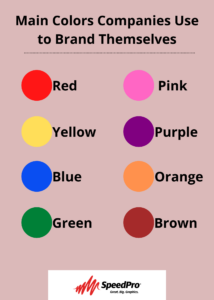
What Are the Best Colors for Corporate Branding?
APRIL 15, 2021| SpeedProCategories
GraphicsWhether your business has a skeleton crew or is a nationwide corporation, you may have found yourself wondering which colors are best suited for your brand. Choosing the right colors for corporate branding is essential, as the psychology of color plays a huge role in a customer’s decision to buy a product or engage with a company. In fact, in the first 90 seconds of initial viewing, an unconscious assessment has already been made by the consumer. Somewhere between 62% and 90% of this assessment is based on color.
If you want to take your brand to the next level and attract your ideal customer, knowing what message you are sending with your color choice is crucial.
Have you ever noticed that many fast-food chains use red in their logos? It’s no accident that nationwide chains like McDonald’s, Burger King, KFC and Dairy Queen all incorporate red into their brand identities. They do this because research indicates the color red stimulates the appetite. By branding themselves with the color red, they signal to the viewer that they can satisfy their cravings.
As the fast food industry indicates, understanding the psychology of color is very important when deciding how to brand your company. If you are a restaurant, you may be tempted to incorporate red into your logo immediately. However, this might not be the right fit for you.
There is no one size fits all approach when it comes to choosing the best color for your brand. The best colors for corporate branding are going to be on a case-by-case basis and will need to fit your brand personality. If you want to find the best color for your business, you will need to first understand why it matters and how it is going to affect your customers.
Why Using the Right Color Matters
When someone sees your logo on a product, walks by your storefront on the street or visits your website, they are going to notice the color scheme and have an emotional reaction to it. Of course, this doesn’t mean that a red logo will make the viewer immediately feel like they are starving. But, it does mean the colors are likely going to generate a more subtle, subconscious response in the viewer.
Choosing the wrong color for an advertisement — say, a serious brown for a fun, new children’s toy — may confuse the viewer or simply not catch their attention. If the color scheme is appropriate for the product or company as a whole, you are more likely to create the type of response that you want. Whether or not you recognize it, your color scheme will generate an emotional response in viewers, so it’s essential to know which colors are most likely to deliver the effect you want.
A study broke down the associations of color in marketing and found that color does play a significant role in establishing a brand’s personality, affecting purchases and influencing likeability and familiarity. These findings highlight the importance of color and the need to think deeply about how one wants to brand their company. If you’re going to establish a strong brand identity, having a memorable color scheme is a great place to start.
The Basics of Color
To know which colors you should use for your company, first you need to know the feelings colors typically evoke in audiences. Though there are multiple shades of colors and endless variations, the list below describes the main colors companies use to brand themselves and gives some insight into why companies use these colors:
Yellow
Yellow is an attention-grabbing color that signals optimism, extraversion, friendliness, happiness and cheerfulness. It can also signal feelings of caution and cowardice, along with causing a potential strain on the eyes. Despite its potential downsides, it’s a go-to color for many companies, with National Geographic, IKEA, and Sprint all employing it in their logos.
Blue
Blue represents intelligence, communication, trust, efficiency, duty and logic. It is a calming and dependable color that is very popular among companies. Many restaurants avoid using the color blue, however, due to the belief that it may suppress appetites. Due to its trustworthiness, financial institutions like JP Morgan, Chase and Bank of America all use blue as their primary color.
Green
Green evokes feelings of nature and security. It helps convey an idea of growth, newness, calm and stability. Darker greens can also relate to wealth, but this is primarily found in the United States where money is green, rather than in other countries whose currency is a different color. Companies like John Deere and Land Rover use green to show their connection with nature.
Purple
Purple associates royalty, wealth, success and wisdom. Due to its rarity in nature, it’s linked to things that are otherworldly or imaginative. For example, the Syfy channel’s logo is purple, speaking to their science fiction and fantasy content.
Red
Red elicits feelings of arousal, excitement and stimulation. It has romantic connotations like passion and love, while also relating to power and war. The color is highly visible and is good at grabbing a customer’s attention. However, it can also signal danger and aggression. Since it is an attention-grabbing and evocative color, a wide variety of companies like Heinz, CNN and Exxon use it.
Orange
Orange relates closely to red, as it also provokes feelings of arousal and excitement, just on a less intense level. It’s a multi-use color, as it can also bring out feelings of joy and playfulness. You can find this highly emotive color on the logos of companies like Fanta, Discover and Amazon.
Pink
Pink often draws out feelings of innocence, softness, sophistication and delicateness. In contemporary times, it has mostly been tied to femininity, but this is changing as pink becomes more popular in men’s fashion. The color can make a bold statement, while it can also be more light-hearted and gentle. Companies like Baskin Robbins, Vineyard Vines and Lyft all include the color in their logo for different effects.
Brown
Brown can bring out feelings of seriousness, reliability, support and neutrality. It can also be used to relate to nature and earthiness. Brown is not very emotionally charged or excited, but it gives a sense of utility that many people look for in a company. As such, UPS, Cracker Barrel and Hershey’s all use the color to remind customers of their reliable service or product.
Black
Black symbolizes power, sophistication, dignity, glamour and authority. The sleek, modern appeal of black makes it popular and can elicit strong feelings from viewers. Despite its appeal, companies have to be aware that the color can also symbolize evil and grief. Fashion companies like Gucci, Chanel and Nike all use black in their logo to complement their trendsetting products.
White
White associates with purity, cleanness, simplicity, hygiene and peace. These positive connotations make white a very attractive choice for companies, and the color is often used as a background. Companies like Apple, Crocs, Cotton and Tesla have all paired white with a variety of colors to great effect.
The Bottom Line
There is a lot of meaning behind brand colors that you might not have been aware of until now. The above list is not exhaustive, but it should give you some idea about what impression you might be making about your brand identity with the colors you choose to incorporate into your brand.
Of course, the above colors will not always produce the same feelings in your audience. A person’s experiences, upbringing and cultural background all change their perception of certain colors. You should still take the general public perception of color into consideration when branding your company and look into how color perception might change based on where you are marketing.
The Best Color for Corporate Branding
When deciding how to brand your company, the number of colors and their various effects on audiences can make it overwhelming to decide on the correct scheme for you. To make it easier for yourself, you should ask a few questions to narrow down your search:
1. What Is Your Brand Personality?
When choosing the right colors for your company, you should start by establishing your brand identity. A brand’s personality is essentially a set of human characteristics that are attributed to a brand name.
Understanding your brand personality will help you know which colors will match up well with the personality you are attempting to cultivate. Before you choose a color, first make sure you understand your brand. Stanford professor Jennifer Aaker has studied brand personality and found that five key dimensions make up a brand’s personality:
- Sincerity. This personality is used by organizations that want to communicate that they are down-to-earth, honest, wholesome and cheerful.
- Excitement. This company can be described as daring, spirited, imaginative and up-to-date.
- Competence. This brand values being reliable, responsible, intelligent and successful.
- Sophistication. This personality is perceived as upper-class, glamorous, romantic and charming.
- Ruggedness. This company is viewed as outdoorsy, tough and strong.
Though brands may have traits from all five of these dimensions, they typically will rely on one of them to create brand familiarity with their customer. For example, if you’re a high-end fashion store, you want to push your sophistication and glamor over your responsibility. Customers are likely coming to your store because they want clothes that they can feel stylish and elegant in, rather than clothes they can wear comfortably around the house, so your branding should play into that desire.
While choosing a color for your brand, your brand personality should be at the forefront of your thoughts. Instead of trying to base your brand around stereotypical color associations (red = exciting), you want to use colors that are going to support the personality you are trying to display.
2. Who Are You Targeting?
Similar to knowing your brand personality, you should also establish who your brand is targeting. Examine whether your company is geared more towards men or women. Through environmental and cultural factors, men and women tend to favor different colors.
In a study, 57% of men stated that blue was their favorite color, while only 35% of women reported the same. Still, both numbers show that a lot of men and women prefer blue. For a more contrasting result, 23% of women said that purple was their favorite color, while less than 1% of men said the same, with 22% of men saying it was their least favorite color. In another study, men preferred bright colors more than women, while women preferred soft colors.
If your company primarily offers products and services to women, knowing which colors are going to be most attractive to your demographic might play a significant role in how you decide to brand yourself. For instance, if you largely market a product for women, you may use softer colors and avoid any colors that women tend not to respond positively to.
You should also note that these preferences by gender are not static and can be changed. As such, it’s important for companies to stay up-to-date on current trends and take the time to read the latest studies on color preferences among different demographics. This same principle applies to any other demographic you might be targeting.
3. What Are the Most Common Colors in Your Industry?
Once you understand your personality and have a sense of who you want to target, you should take a moment to review the major companies in your industry. What colors are these companies using? A lot of time, you will find overlap. For instance, green is found in agriculture, red in retail and blue in tech.
Once you’ve surveyed your field, it’s up to you to decide if you want to stand out from the crowd or go with a more traditional or conservative color scheme. Either option can work, and the decision ultimately comes down to the message you want to send.
4. How Do I Choose Colors That Fit My Corporate Identity?
First, take note that you are not stuck with only one color. In fact, it’s probably better to have multiple colors, especially if they are somehow related to what makes your brand unique.
For instance, Starbucks made its color scheme more personal and unique by changing its primary color to green in 1987, as a nod to the University of San Francisco, where the three founders went to school. Below are a few tips on how to pick out a color scheme:
Though you can have between one and four colors for your brand colors, to begin, it’s best to keep it simple with three colors that you can combine to say something about your brand personality. You are going to choose a base, an accent and a neutral color:
- The base. Think back to your brand’s personality. Which of the five key dimensions best fit your brand? Once you have that personality trait in mind, you can use it to help pick a color that reflects that personality trait. The base color should be a reflection of your most dominant trait, and it should also appeal to your target audience. The color you choose for the base will inform the other two colors, so choose wisely.
- The accent. You should pick a color that matches a brand personality trait for your accent. If you only have one personality trait you want to be known for, that’s okay and even recommended. You can just pick another color that matches your dominant personality trait and that pairs well with your base color. This color is a little more challenging to choose, but a visually appealing accent can make all the difference.
- The neutral. This color will probably be your background color. Since it’s in the background, you’ll want it to be low-key, using different shades of gray, beige, white or off-white to make the rest of your colors pop. Though you can use black as a background color, it will draw more attention to itself than other colors.
5. What Are Some of the Most Common Color Palettes?
If you’re still unsure which colors will best fit your corporate identity, you can rely on some color palettes that many companies employ. There are five color palettes to consider when you are trying to put colors together:
- Monochromatic. One of the most popular, monochromatic palettes will have you combining various shades and tints of a single color on the color wheel.
- Complementary. This palette combines colors that are directly opposite each other on the color wheel. A combination of warm and cool colors, this palette will stand out.
- Analogous. A very harmonious palette that will combine colors that are next to each other on the color wheel. Since the colors stay consistent, you will create a very recognizable brand color scheme.
- Triad. With a triad palette, you use three colors that are equal distance from each other on the color wheel. Generally, you will only have one dominant color and two supporting colors if you use this palette to design your brand colors.
- Neutral with a pop of color. This color palette relies on an array of neutral colors with only one color that stands out from rest. You can go with a bright or more subdued color to great effect.
If you’re still having trouble figuring out your brand color scheme, you can always try online color scheme generators that will produce a scheme for you, or you can go look at other palettes to get ideas for your corporate branding efforts.
Ready to Bring Your Colors to Life?
If you’re ready to advertise your company with eye-catching graphics unique to your brand, SpeedPro can help. As the only nationwide network that focuses on large-format graphics, we know the ins and outs of what will make your colors pop. From window graphics to murals, signs, vehicle wraps and trade show displays, SpeedPro can help you print the best-looking graphics in the industry.
All of our franchises have proven their ability to deliver exceptional service, on-time products and memorable graphics to our customers. Find and contact your local studio today to request a quote and discuss your options.






















